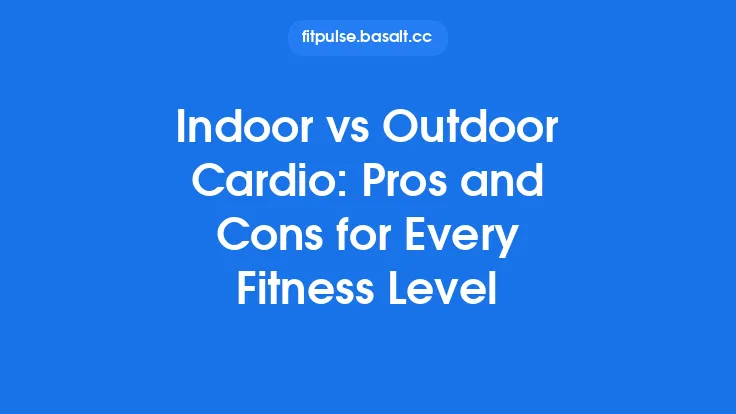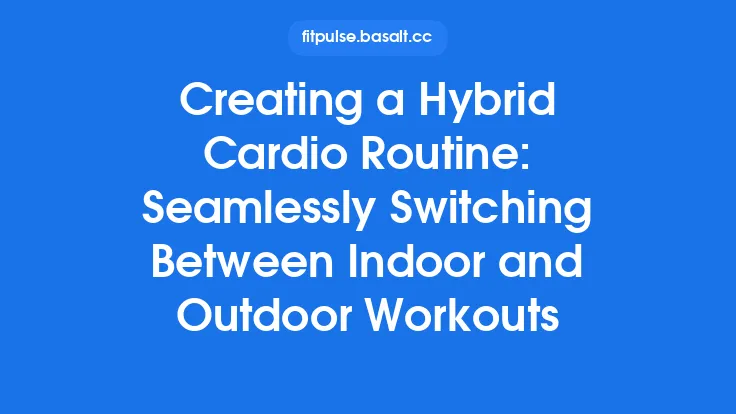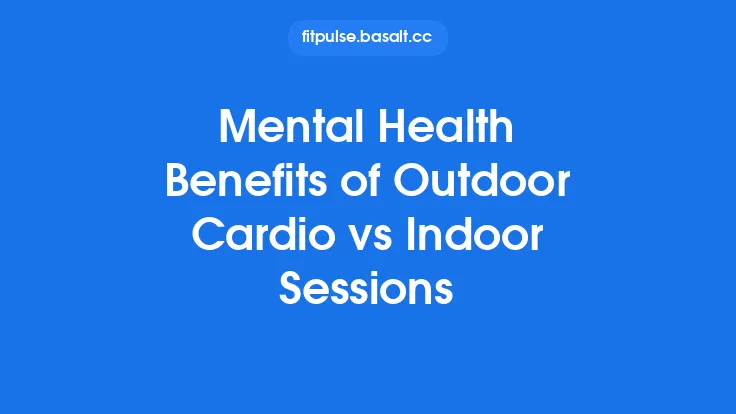Row rowing has long been celebrated as one of the most efficient full‑body cardiovascular workouts, yet the environment in which you perform it—indoors on a rowing machine or outdoors on the water—can dramatically shape the experience, the physiological adaptations, and the way you structure your training. Understanding these differences is essential for athletes, fitness enthusiasts, and anyone looking to maximize the health and performance benefits of rowing while aligning the modality with personal goals, lifestyle constraints, and seasonal considerations.
The Core Physiological Demands of Rowing
Regardless of setting, rowing engages the legs, core, and upper body in a coordinated, cyclic motion that simultaneously taxes the aerobic and anaerobic energy systems. The primary muscle groups involved include the quadriceps, gluteals, hamstrings, erector spinae, latissimus dorsi, and forearm flexors. Because the movement is both push‑and‑pull, heart rate and oxygen consumption rise quickly, often reaching 70‑85 % of VO₂max during sustained efforts. This makes rowing an excellent modality for improving:
- Cardiovascular endurance – prolonged sessions develop stroke volume and capillary density.
- Lactate threshold – interval work pushes the body to clear lactate more efficiently.
- Muscular endurance and strength – repeated high‑force drives build both slow‑twitch and fast‑twitch fiber recruitment.
- Metabolic flexibility – the alternating emphasis on lower‑body power and upper‑body pull encourages the body to switch fluidly between carbohydrate and fat oxidation.
The underlying physiology is identical whether you’re pulling a handle on a stationary ergometer or a blade through water; the divergence lies in external variables that influence how those demands are delivered and perceived.
Environmental Variables: What Changes When You Move Outdoors?
| Variable | Indoor Rowing (Ergometer) | Outdoor Rowing (Boat) |
|---|---|---|
| Resistance | Preset or programmable (air, magnetic, water‑flywheel) – consistent across sessions | Dependent on water conditions (current, wind, wave chop) – naturally variable |
| Temperature & Humidity | Climate‑controlled gym environment | Exposure to ambient weather; thermoregulation becomes a training factor |
| Stability & Balance | Fixed seat, no need for balance | Boat stability varies with hull design, water state, and crew weight distribution |
| Sensory Feedback | Visual display of metrics, auditory cues from machine | Visual horizon, tactile feel of water, auditory cues from wind and splash |
| Safety Considerations | Minimal – risk limited to equipment malfunction | Requires knowledge of water safety, navigation, and rescue protocols |
These variables affect not only the physiological load but also the psychological experience of rowing. For instance, the unpredictable resistance of a windy day can produce “natural intervals,” forcing the rower to adapt in real time, whereas an ergometer offers a repeatable, data‑driven platform ideal for precise performance tracking.
Benefits Unique to Indoor Rowing
- Data Precision and Repeatability
Modern rowing machines provide split times, power output (watts), stroke rate, and even integrated heart‑rate zones. This granularity enables athletes to follow strict progressive overload protocols, benchmark against personal bests, and conduct controlled experiments (e.g., testing a new pacing strategy) without external interference.
- Weather‑Independent Consistency
Training can be scheduled year‑round, regardless of rain, temperature extremes, or daylight availability. This reliability is especially valuable for athletes who need to meet specific training volume targets within a limited calendar window.
- Safety and Accessibility
Beginners can learn the basic movement pattern without the added complexity of balance or water safety. Gyms often have multiple machines, allowing for group classes or simultaneous individual sessions.
- Space Efficiency and Convenience
An ergometer occupies a fraction of the space required for a boat and dock, making it feasible for home gyms, corporate wellness rooms, or rehabilitation clinics.
Benefits Unique to Outdoor Rowing
- Dynamic Resistance and Skill Development
The ever‑changing water conditions demand real‑time adjustments in power application, timing, and balance. This cultivates a higher level of proprioceptive awareness and adaptability that translates to improved performance in variable race environments.
- Holistic Environmental Conditioning
Exposure to wind, temperature fluctuations, and sunlight engages thermoregulatory mechanisms, respiratory adaptations (e.g., breathing through varying humidity), and mental resilience. Athletes often report heightened mental toughness after regular on‑water sessions.
- Full‑Body Coordination and Balance
Maintaining boat stability while executing the rowing stroke activates deep core stabilizers and neuromuscular pathways that are less emphasized on a stationary machine. This can lead to superior functional strength for activities beyond rowing.
- Scenic and Motivational Elements
The visual stimulus of water, horizon, and natural surroundings can reduce perceived exertion, improve mood, and increase adherence to training programs, especially for those who find indoor environments monotonous.
Designing a Hybrid Training Plan
Because each environment offers distinct advantages, many athletes adopt a hybrid approach—leveraging indoor sessions for precision work and outdoor sessions for skill refinement and environmental conditioning. Below is a framework for integrating both modalities across a typical week, adaptable for beginners to elite rowers.
1. Establish Baseline Metrics
- Indoor Test: Perform a 2,000‑meter time trial on the ergometer. Record average split, peak power, and heart‑rate zones. This provides a quantifiable baseline for tracking progress.
- Outdoor Test: Conduct a 5‑kilometer row on calm water, noting average speed (km/h) and perceived effort. Use a GPS‑enabled device or a rowing-specific smartwatch for consistency.
2. Weekly Structure (Example: 5‑Day Schedule)
| Day | Session Type | Focus | Duration / Intensity |
|---|---|---|---|
| Monday | Indoor | Aerobic base | 45 min steady‑state at 65‑70 % VO₂max (≈ 20‑22 spm) |
| Tuesday | Outdoor | Technical & balance | 30 min moderate row (70‑75 % VO₂max) focusing on smooth catch and boat stability |
| Wednesday | Rest or active recovery | Mobility & flexibility | Light stretching, foam rolling |
| Thursday | Indoor | Interval power | 8 × 500 m intervals, 1:30 min rest, target 90‑95 % max power |
| Friday | Outdoor | Endurance + environmental adaptation | 60 min long row, varying intensity with natural water changes |
| Saturday | Optional cross‑modal | Skill drills (e.g., “pause” drills) on either platform | 20‑30 min low‑intensity |
| Sunday | Rest | Full recovery | — |
Key Principles
- Progressive Overload: Increase total weekly volume by ~5‑10 % every 2‑3 weeks, alternating between indoor and outdoor sessions to avoid monotony.
- Specificity: If preparing for a race on water, allocate a higher proportion of outdoor rows in the final 4‑6 weeks, emphasizing race‑pace intervals and boat handling.
- Recovery Management: Outdoor rows often impose additional systemic stress (thermal load, balance). Schedule lighter indoor days after intense on‑water sessions to facilitate recovery.
3. Periodization Considerations
- Macrocycle (Annual): Divide the year into phases—foundation (indoor‑heavy), skill acquisition (balanced), competition (outdoor‑heavy), and transition (low‑volume, mixed).
- Mesocycle (4‑6 weeks): Within each phase, rotate emphasis every 2 weeks (e.g., 2 weeks of high‑intensity intervals on the ergometer, followed by 2 weeks of variable‑resistance rows on water).
- Microcycle (Weekly): Use the table above as a template, adjusting volume and intensity based on fatigue markers (HRV, resting HR, subjective wellness).
Programming Specific Workouts for Each Modality
Indoor Rowing Workouts
- Power Pyramid
Warm‑up: 10 min easy rowing (18‑20 spm).
Main Set: 250 m @ 95 % max power → 500 m @ 90 % → 750 m @ 85 % → 500 m @ 90 % → 250 m @ 95 %. Rest 2 min between each segment.
Cool‑down: 5 min light rowing.
- Heart‑Rate Zone Intervals
6 × 4 min at 80‑85 % HRmax, 2 min active recovery at 60 % HRmax. This targets lactate threshold while providing clear cardiovascular metrics.
Outdoor Rowing Workouts
- Wind‑Resistance Intervals
On a day with moderate cross‑wind, perform 5 × 3‑minute high‑intensity rows (aim for 85‑90 % perceived effort) followed by 3 minutes of easy rowing. The wind naturally adds resistance, simulating interval overload without mechanical adjustments.
- Progressive Long Row
Start at a comfortable pace for the first 15 minutes, then increase stroke rate by 2 spm every 10 minutes, finishing the last 15 minutes at a challenging but sustainable pace. This mimics race‑day pacing while allowing the rower to adapt to changing water conditions.
Monitoring Progress Without Over‑Emphasizing Technology
While indoor machines provide abundant data, outdoor rowing often relies on more qualitative measures. Combining both yields a comprehensive picture:
- Performance Logs: Record date, weather, water conditions, perceived exertion (RPE 1‑10), and any notable technical observations (e.g., “boat pitched forward on a wave”).
- Heart‑Rate Trends: Use a waterproof chest strap or optical monitor to track average and peak HR during outdoor rows; compare against indoor session HR zones.
- Power Estimates: Some modern rowing watches estimate power based on stroke rate and boat speed; use these as a relative gauge rather than an absolute metric.
- Recovery Indicators: Track sleep quality, resting HR, and subjective fatigue to adjust the balance between indoor and outdoor volume.
Safety and Injury Prevention in Both Settings
Even though the article avoids deep technique instruction, a brief reminder of safety fundamentals is prudent:
- Indoor: Ensure the foot stretcher is correctly positioned, the damper or resistance setting matches your fitness level, and the seat rail moves smoothly. Periodically inspect the chain or belt for wear.
- Outdoor: Conduct a pre‑row safety check—hull integrity, oarlocks, personal flotation device (PFD), and weather forecast. Always row with a partner or inform someone of your planned route and expected return time.
Choosing the Right Modality for Your Goals
| Goal | Recommended Emphasis |
|---|---|
| Maximize VO₂max | Indoor high‑intensity intervals (precise power control) |
| Improve Race‑Day Boat Handling | Outdoor sessions in varied conditions |
| Consistent Training Volume | Indoor sessions during inclement weather or travel |
| Holistic Conditioning (thermal, balance, mental) | Outdoor rows, especially in moderate climates |
| Rehabilitation or Low‑Impact Cardio | Indoor rowing with controlled resistance and reduced impact on joints |
Most athletes will find that a blend—using indoor rowing for data‑driven, repeatable work and outdoor rowing for skill, adaptability, and environmental conditioning—delivers the most balanced development.
Final Thoughts
Indoor and outdoor rowing are not competing modalities; they are complementary tools within a comprehensive cardiovascular conditioning toolbox. By recognizing the unique physiological stresses, environmental variables, and training opportunities each setting provides, you can craft a nuanced program that leverages the precision of the ergometer and the dynamic realism of the water. Whether you’re training for a sprint race on a lake, seeking a year‑round cardio staple, or simply looking to enhance overall fitness, understanding and strategically integrating both indoor and outdoor rowing will help you achieve sustainable progress and keep the experience fresh and engaging.





